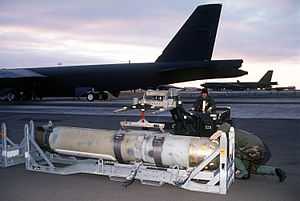Mark 60 CAPTOR
From Wikipedia, the free encyclopedia
| Mark 60 CAPTOR | |
|---|---|
 Mark 60 mine being loaded into a B-52 Stratofortress at Loring Air Force Base in 1989 | |
| Type | Antisubmarine naval mine |
| Place of origin |
|
| Service history | |
| In service | 1979 |
| Used by |
|
| Wars | Cold War |
| Production history | |
| Manufacturer | Alliant Techsystems |
| Specifications | |
| Weight |
Aircraft/ship-laid:1,077 kg (2,374 lb) Submarine-laid:935 kg (2,061 lb) |
| Length |
Aircraft/ship-laid:3.68 m (145 in) Submarine-laid:3.35 m (132 in) |
| Diameter | 530 mm (21 in) |
|
| |
| Effective firing range | 8,000 yards (7,300 m) |
| Warhead | Mark 46 torpedo |
| Warhead weight | 44 kg (97 lb), PBXN-103 |
|
| |
| Engine | Two-speed, reciprocating external combustion |
| Propellant | Otto fuel II |
| Maximum depth | 3,000 feet (910 m) |
| Speed | >28 knots (52 km/h) |
Guidance system | Active or passive/active acoustic homing, snake or circle search, reliable acoustic path (RAP) sound propagation |
Launch platform | Aircraft, surface ship and submarines |
The Mark 60 CAPTOR (Encapsulated Torpedo) is the United States Navy's primary anti-submarine naval mine. This deep-water mine is laid by ship, aircraft or submarine, and is anchored to the ocean floor. When its sonar detects a hostile submarine, the CAPTOR launches a Mark 46 torpedo.[1]
The name CAPTOR is short for enCAPsulated TORpedo.[1] The CAPTOR was the U.S. Navy's standard anti-submarine mine during the Cold War, having enough computer power to detect the difference in acoustic signature between ships and submarines. When an enemy submarine passes close by, the passive sonar detects it and releases the torpedo, which tracks the sound until it contacts the submarine hull and explodes.
References
- ↑ 1.0 1.1 Thomas, Vincent C. The Almanac of Seapower 1987 Navy League of the United States (1987) ISBN 0-9610724-8-2 p.191
External links
| Wikimedia Commons has media related to CAPTOR mine. |
This article is issued from Wikipedia. The text is available under the Creative Commons Attribution/Share Alike; additional terms may apply for the media files.